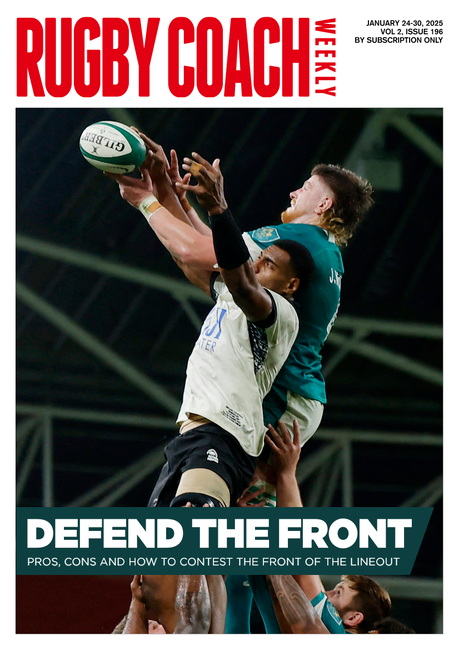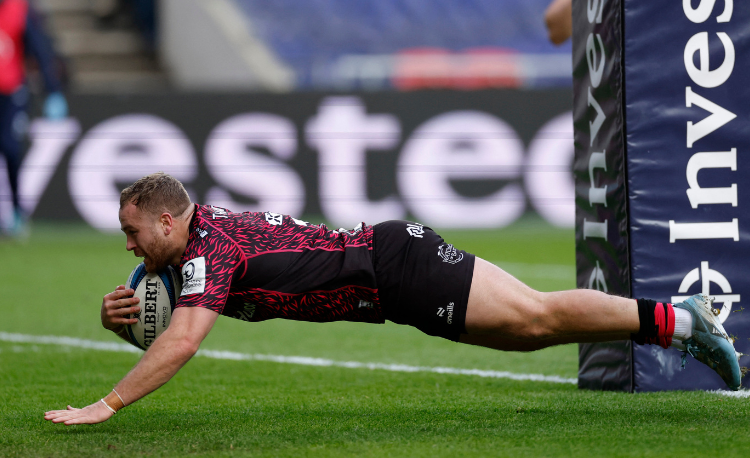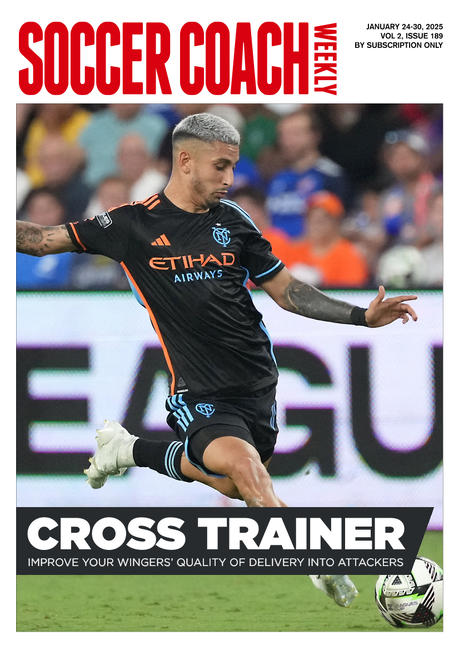Attack from a standing start
RCW editor Dan Cottrell adds more context to two practices.
You don’t want your players to take the ball standing still. However, sometimes it makes some sense.
A flat pass, one which is parallel to the opposition try line, loses you little ground. A player who merely has to move forward one or two steps to take this pass has more chance to adjust their body angle and do it under control.
If the pass is quick, and the ball carrier can adjust their angle effectively, and then use some evasive skill, they can dent the defensive line, thus creating go-forward for the next phase.
Let’s be clear: you are not expecting to break the line. It’s a safety play. Training for it is a contingency for those times when players mistime their runs and end up close to the line and static.
This session works on what I call ‘flat speed’ – that is, creating as much speed as possible in a very short distance. It also refers to the speed of adjustment of the body height, angle and ball position, to ensure the ball carrier doesn’t lose the contact battle.
This session is mainly aimed at forwards. In the modern game, a static forward receiving the ball might make a short pass to another player, called a ’tip-on’ pass. This can slightly wrong-foot the opposition defenders.
Alternatively, and I see this more and more, the player generates some speed by running across the pitch first, before angling towards the opposition try line.
The ball is moved to the outside arm, that’s away from the opposition, before they then drive to the outside shoulder of a defender.
Some coaches suggest that the attacker shouldn’t go for a gap between defenders. If they do, they are likely to be double-teamed. The first defender brings them down, the second goes to steal the ball. The alternative is to attack just one defender and win that battle.
Using the flat speed session, players can explore all these technique, tactics and others.
In summary, they might try:
- Running across the pitch a little before turning up the pitch, thus gathering some speed.
- Attacking just one defender.
- Using a twist before contact – see this session for ways to practise this.
- Finding the right body height to attack.
Training tips
- This will turn into a very physical session. In fact, players will really enjoy the challenges, especially the front rowers! Build it up gradually, before reaching the highest intensity.
- Don’t be afraid to overload the defence to make the attackers work even harder.
- Keep the distances between attack and defence short. Don’t allow run ups.
- Explore the use of ’latches’, where a second attack binds onto the ball carrier to help drive them through contact.
Support shapes
Support is one of the hardest parts of the game to coach specifically.
Because the ball carrier moves to beat defenders, or then passes, the supporting player’s role might change many times in the space of just a few strides.
They might be in position to take a pass, receive an offload, drive the ball carrier through the contact, drive off a defender or simply be moving to support the next ball carrier.
The French sides of old used to talk about the support player in relation to the ball as a relation.
They might be called brothers or cousins, depending on how close they are to the ball carrier. It helped them decide on the level of support, and what their role might be at the next breakdown.
When the ball carrier is close to the defence, and the defence is organised, the support has to be in behind the ball carrier, as well as to the side.
The picture of Jordie Barrett above illustrates this well, with two of his team-mates in support.
Sometimes we can call this a diamond formation, with the ball carrier at the apex.
Whether you like to frame it as a formation or a family, the main themes to coach the support players are:
- Can I receive a pass?
- Can I win the race for the ball if the ball carrier gets tackled?
Keep these two simple ideas in mind, and the complications of coaching support become a little easier.
It also helps if the players communicate, too, but that’s another challenge for you.
Related Files
Newsletter Sign Up
Coaches Testimonials

Gerald Kearney, Downtown Las Vegas Soccer Club

Paul Butler, Florida, USA

Rick Shields, Springboro, USA

Tony Green, Pierrefonds Titans, Quebec, Canada
Subscribe Today
Be a more effective, more successful rugby coach
In a recent survey 89% of subscribers said Rugby Coach Weekly makes them more confident, 91% said Rugby Coach Weekly makes them a more effective coach and 93% said Rugby Coach Weekly makes them more inspired.
Get Weekly Inspiration
All the latest techniques and approaches
Rugby Coach Weekly offers proven and easy to use rugby drills, coaching sessions, practice plans, small-sided games, warm-ups, training tips and advice.
We've been at the cutting edge of rugby coaching since we launched in 2005, creating resources for the grassroots youth coach, following best practice from around the world and insights from the professional game.










